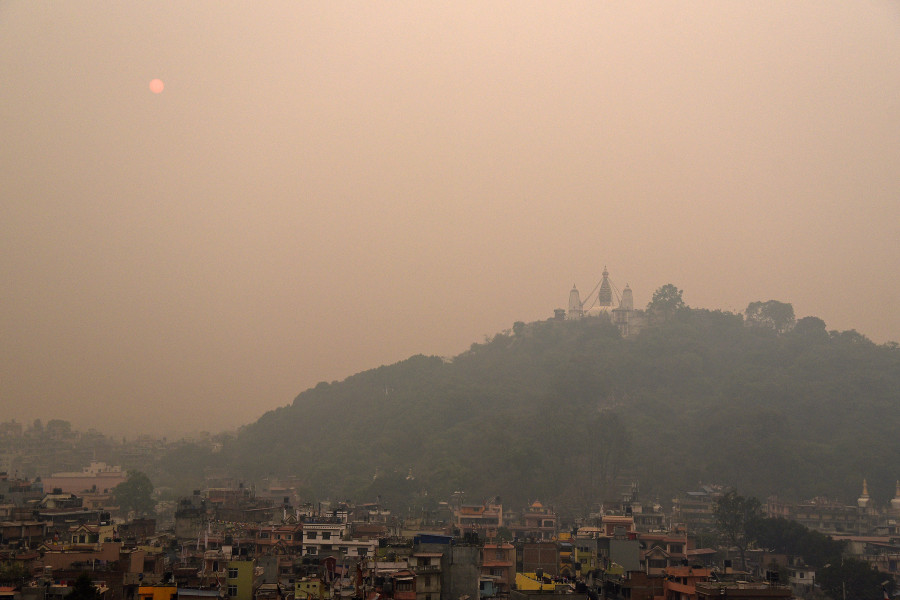Columns
A vision from the future
As difficult as it is to digest, brown skies and a dim sun are here to stay.
Amish Raj Mulmi
The past few days have felt like a vision from the future: sepia-tinted skies, with the sun unable to pierce a thick wall of grey clouds, and a general feeling of being trapped under a dome of smoke. For those of us who’ve been to Delhi, the pall of unyielding dread was familiar. As the winter approaches, the firecrackers have erupted and the crops are burnt in the fields of Punjab and Haryana, the Indian capital witnesses a similar sight, year after year. The recent forest fires blazing across Nepal’s forests are the primary cause behind the haze, but tied to it is the paucity of winter rain, which has also affected agricultural output. Such unnatural conditions are increasingly becoming common in the Anthropocene, an era when humans have had a terrible impact on the climate.
Readers of this column will have noted my defeatist views on climate change. Much of these views were shaped in the aftermath of author Elizabeth Kolbert’s The Sixth Extinction, in which she argued cogently about the human race’s impact on the planet, and how we’ve reshaped the natural order irrevocably. Kolbert’s new book, Under a White Sky: The Nature of the Future, extends this framework and takes the reader to meet several scientists who are working under the assumption that the planet has already changed, and are using path-breaking technologies such as CRISPR to either slow down the devastation wrought by mankind on the natural world, or to bring us radical new alternatives, such as blocking out the sunlight using geoengineering. For example, she meets with German-born physicist Klaus Lackner, whose first ‘crazy, big idea’ was to install a solar farm as big as Nigeria, which would be ‘sufficient to remove all the carbon dioxide emitted by humans up to that point’ by converting the CO2 into rock.
The tech sounds like something out of a science fiction novel, because it is. Lackner’s CO2-pulling tech is still in its prototype—the powder from beads that ‘were composed of a resin normally used in water treatment’ will absorb CO2, and need to be deployed on a massive scale to have any effect. While much of the science was quite esoteric, what interested me most was Lackner’s belief that ‘[w]e need to change the paradigm’. ‘Carbon dioxide, in his view, should be regarded much the same way we look at sewage. We don’t expect people to stop producing waste… One of the reasons we’ve had such trouble addressing the carbon problem, [Lackner] contends, is the issue has acquired an ethical charge. To the extent that emissions are seen as bad, emitters become guilty. “Such a moral stance makes virtually everyone a sinner and makes hypocrites out of many who are concerned about climate change but still partake in the benefits of modernity.”’
Such a stance is different than the usual narrative on tackling climate change. Of course we need to cut down our reliance on fossil fuels and switch to renewables. But at the same time, even if humans are able to switch off all their emissions at once, it is unlikely we will see immediate changes. Kolbert writes, ‘Were we to halve emissions—a step that would entail rebuilding much of the world’s infrastructure—CO2 levels wouldn’t drop; they’d simply rise less quickly.’
What makes the people Kolbert meets in the course of her book most interesting is that all of them approach the issue from the belief that humans have wrought irrevocable and irreversible damage on the planet. ‘I’m a realist,’ a scientist who was working to engineer coral reefs to withstand the rising acidic levels of our seas tells Kolbert. ‘I cannot continue to hope that our planet is not going to change radically. It already is changed.’ But Kolbert’s book is not one about optimism; it is about how human beings are intervening—much like how our interventions changed this planet—to halt or slow down the hand that nature will deal us in the years to come. As she says, it is less ‘techno-optimism’ as ‘techno-fatalism’: these innovations aren’t ‘improvements on the original; they were the best that anyone could come up with, given the circumstances.’
That climate change is real is undeniable. But the effects it will have on lower-income countries like ours will be of a far greater magnitude than in richer countries. And yet, we have continued to pursue a concretised model of development despite arguing developed countries have a greater moral role in reducing their emissions (since they continue to pollute far more). Such a model of growth—which emphasises man’s ability to change nature and play god—doesn’t look like it will go away anytime soon. But nature is not bound by borders; the smoke from our forest fires reached Tibet and Bhutan, and the crops burnt in Punjab affected our weather too. The solutions, however, are mired in politics and inter-country relationships, and the human ego above all.
When the science of climate change overwhelms ordinary readers like us, it is often writers who look at the natural world with a different eye who provide succour. Author Helen MacDonald writes in her new collection of essays on nature, ‘What science does is what I would like more literature to do too: show us that we are living in an exquisitely complicated world that is not all about us. It does not belong to us alone.’ Deploying the written word to highlight the loss we’ve already faced—the number of species that have gone extinct or will soon; the devastation of our forests in favour of monoculture plantations, grazing grounds or new airports—can soothe a restless mind. But the lingering fear of what is to come never goes away. After all, the stark reality is that there will be more sepia skies and a dim sun in the days to come.




 9.12°C Kathmandu
9.12°C Kathmandu













%20(1).jpg&w=300&height=200)

